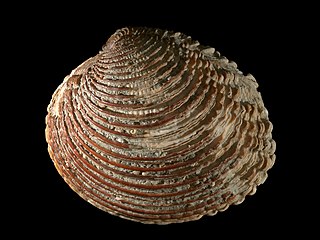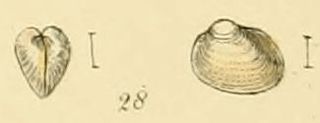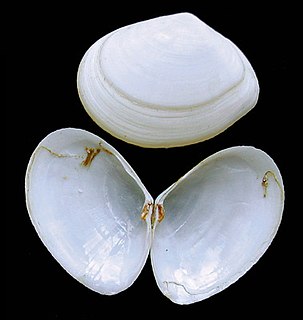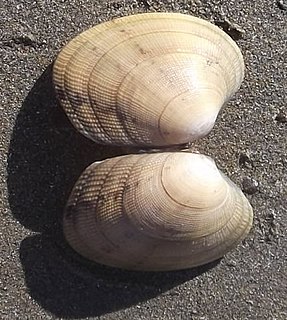
The Veneridae or venerids, common name: venus clams, are a very large family of minute to large, saltwater clams, marine bivalve molluscs. Over 500 living species of venerid bivalves are known, most of which are edible, and many of which are exploited as food sources.

Pisidium casertanum, the pea cockle or pea clam, is a minute freshwater bivalve mollusc of the family Sphaeriidae.

Pisidium amnicum is a species of very small freshwater clam, sometimes known as the greater European peaclam or the River pea shell. It is an aquatic bivalve in the family Sphaeriidae.
Pisidium moitessierianum is a species of minute freshwater clam. It is an aquatic bivalve mollusc in the family Sphaeriidae.

Pisidium subtruncatum is a species of pill clam, a minute freshwater bivalve in the family Sphaeriidae.

Pisidium obtusale is a species of freshwater bivalve from family Sphaeriidae.

Pisidium is a genus of very small or minute freshwater clams known as pill clams or pea clams, aquatic bivalve molluscs in the family Sphaeriidae, the pea clams and fingernail clams.

Pisidium lilljeborgii is a species of freshwater bivalve from the family Sphaeriidae.

A micromollusk is a shelled mollusk which is extremely small, even at full adult size. The word is usually, but not exclusively, applied to marine mollusks, although in addition, numerous species of land snails and freshwater mollusks also reach adult size at very small dimensions.

A bivalve shell is part of the body, the exoskeleton or shell, of a bivalve mollusk. In life, the shell of this class of mollusks is composed of two hinged parts or valves. Bivalves are very common in essentially all aquatic locales, including saltwater, brackish water, and freshwater. The shells of bivalves commonly wash up on beaches and along the edges of lakes, rivers, and streams. Bivalves by definition possess two shells or valves, a "right valve" and a "left valve", that are joined by a ligament. The two valves usually articulate with one another using structures known as "teeth" which are situated along the hinge line. In many bivalve shells, the two valves are symmetrical along the hinge line—when truly symmetrical, such an animal is said to be equivalved; if the valves vary from each other in size or shape, inequivalved. If symmetrical front-to-back, the valves are said to be equilateral, and are otherwise considered inequilateral.

Pisidium clessini is a species of extinct freshwater bivalve from family Sphaeriidae.

Mya truncata, common name the blunt gaper or truncate softshell, is a species of edible saltwater clam, a marine bivalve mollusk in the family Myidae.

Amphicyclotulus amethystinus is a species of tropical land snail with a gill and an operculum, a terrestrial gastropod mollusk in the family Neocyclotidae.

Helicina guppyi is a species of tropical land snail with an operculum, a terrestrial gastropod mollusk in the family Helicinidae.

Venerupis decussata is a marine bivalve mollusc in the family Veneridae, commonly known as the cross-cut carpet shell.

Thracia convexa is a bivalve mollusc in the family Thraciidae.

Poromya granulata, or the granular poromya, is a species of marine bivalve mollusc in the family Poromyidae. It is unusual among bivalves in being carnivorous. It is found in more northerly parts of the Atlantic Ocean.
Laternula elliptica is a species of saltwater clam, a marine bivalve mollusc in the family Laternulidae, the lantern shells. It is the largest bivalve found under the surface of the seabed in the Southern Ocean.

















